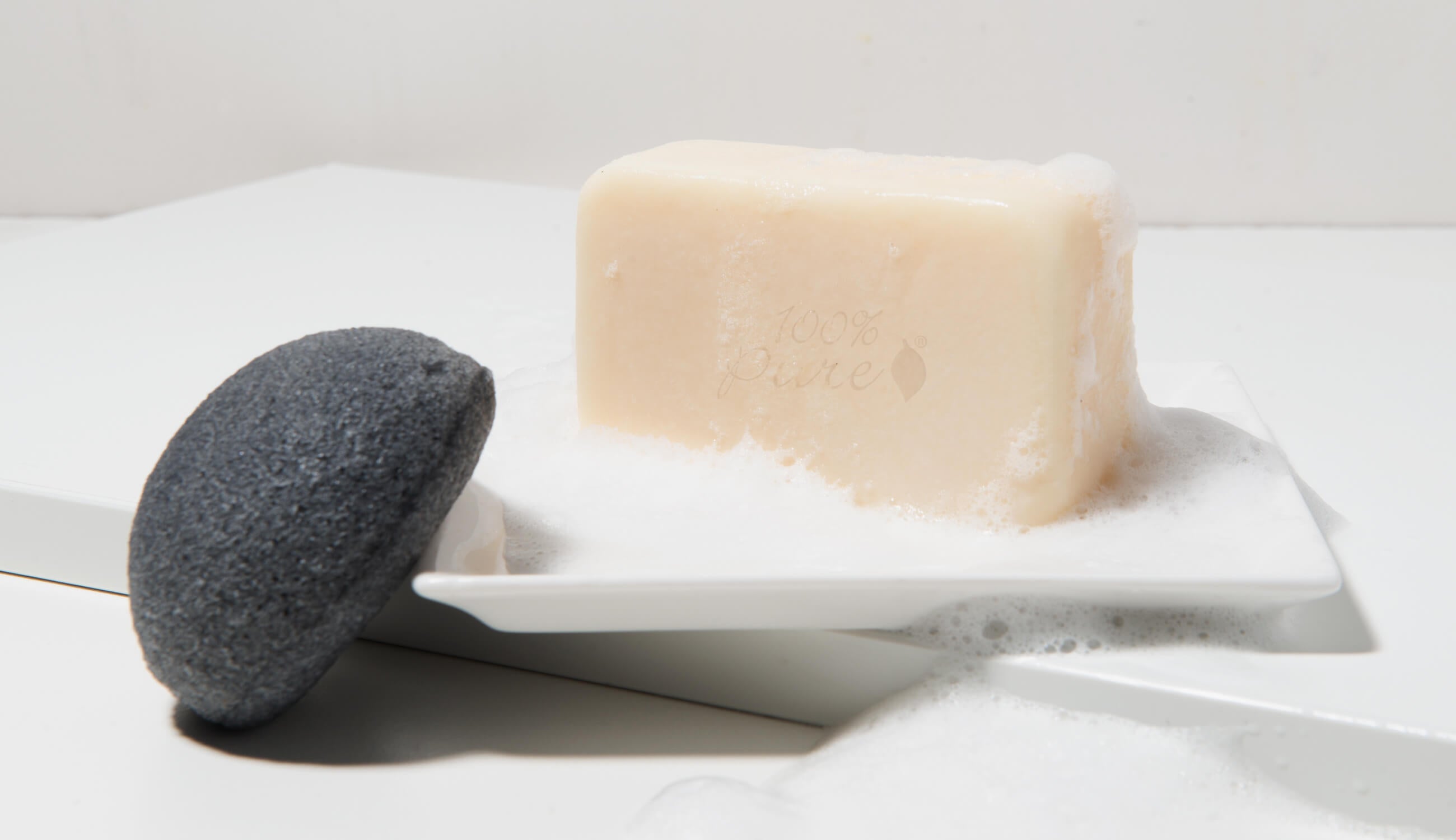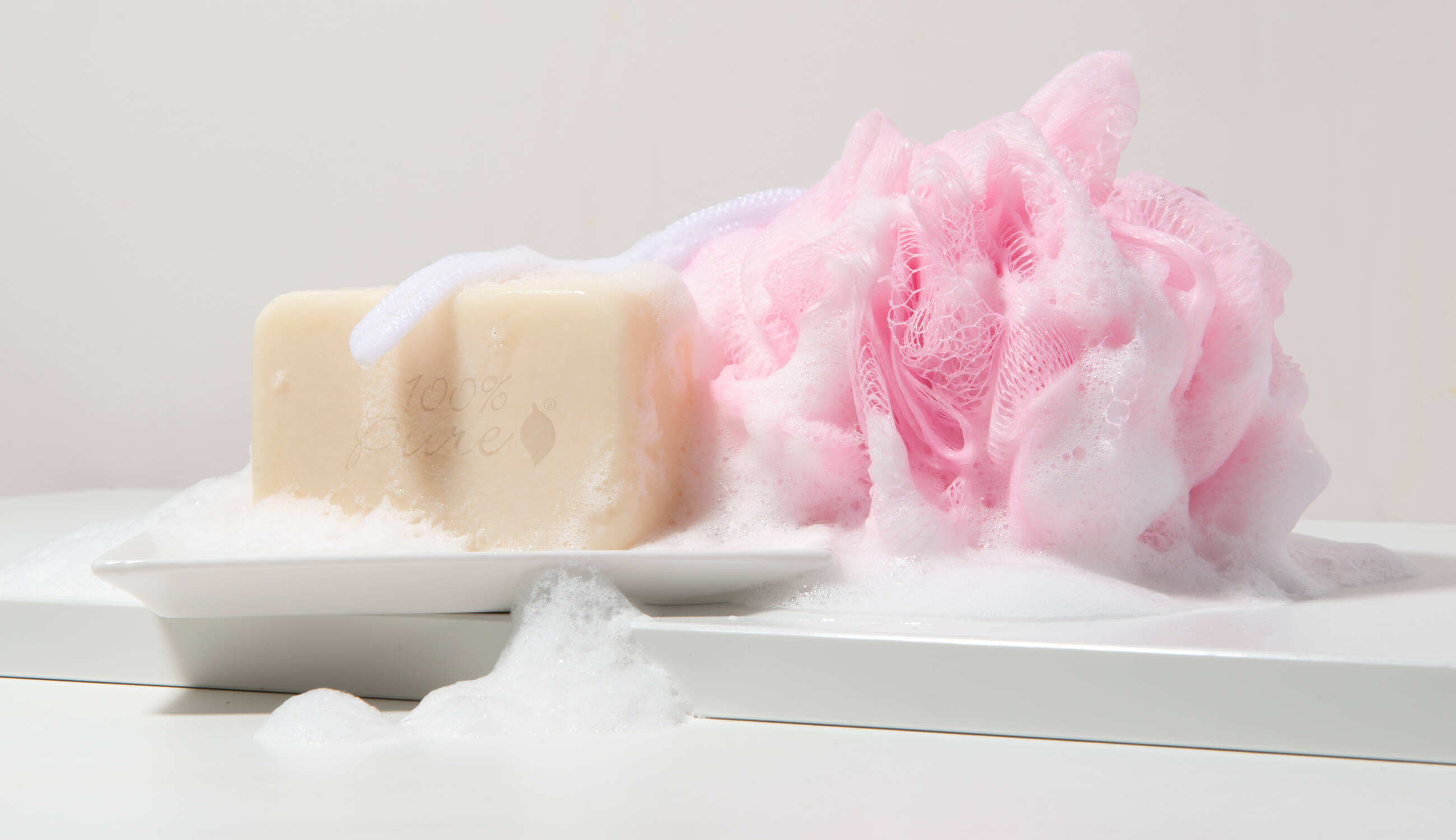Dirty secrets of bar soaps, and how to spot a truly natural soap
Updated on August 3, 2018 Written by: 100% PURE®
When it comes to soap, we’d all like to think we can trust the products we use. They’re making us clean, right? So how can they be bad? Before we get to that, let’s address the major problem with the soap market.
The overwhelming majority of shoppers have been duped by marketing slogans and catchy jingles. Instead, they should be encouraged to read labels and ask questions. They buy basic personal hygiene products, blindly trusting that these intimately-used products are totally safe. And when it comes to personal care, it doesn’t get more basic than soap. Next time you suds up, consider this: the conventional bar soap you’re using might be causing more harm than good.
Getting Squeaky Clean: A Brief History
Our society’s obsession with staying clean really hit its stride during the Civil War, and has kept its pace ever since. It all started with The Sanitary Commission, a group of women devising ways to support the troops. They urged that lathering up with soap and water could reduce military mortality rates. In addition to trends set by government agencies, it was generally believed that washing with soap could elevate one’s status. Being squeaky clean was even viewed as a form of patriotism, as it created a progressive American ideal around the importance of cleanliness. It created a progressive American ideal around the importance of cleanliness. Bar soap is historically considered the first subject of a major advertising campaign. It's even been suggested that bar soap and advertising helped to establish one another. So when we ask ourselves why we buy which soap, what’s our answer? Is it because it’s the soap we’ve been told to buy for years?

The Problem with Most Soaps
Take a look at live rankings of the most popular bar soap brands in the U.S. on Ranker. You’ll recognize the ones at the top as those you see most often in mainstream media. But how much does marketing have to do with how safe these soaps are for your skin? And on a deeper level, your internal health? The answer is, of course, very little.
Most shoppers won’t stop to consider that what we use topically might hurt us. It’s easier for us to understand how what we ingest can affect us. This is proven by increasing awareness around whole vs. processed foods. Or how what we inhale can affect us, leading to a current slowdown in global cigarette sales. But when it comes to what we put on our skin, bar soap is one of the most heavily applied. Yet we know so little about its effects on our health! Do we really know what’s packed inside those innocuously pastel, freshly scented bars? The answer is often “no”, and the truth will blow you away.
A whopping 60% of bar soap ingredients have been sneaking into your bloodstream for years. These insidious toxins can have serious long term effects on your health. Our skin is the largest organ in our bodies, and its semipermeable membrane can absorb anything applied to it. This process of transdermal absorption means that ingredients in soap will permeate our bloodstream with prolonged use. Guess what that means? It means there are lots of chemical toxins piggybacking on those ‘beneficial’ ingredients in your soap. Sure, your skin might be getting natural soap ingredients promised by the package. But you’re also getting some toxic stowaways.
Unsafe Ingredients Found In Soap
A few of the most unsafe ingredients in soap are various sodiums, triclosan, and triclocarban. We’ll break down just why they should be avoided at all costs, in soap and other personal care products.
Sodiums
One of the main ingredients used in top selling soap bars in the U.S. is Sodium Lauroyl Isethionate. This sodium is an emulsifier and detergent and has no scientific benefits for the health of skin. If “detergent” sounds too harsh for skin, that’s because it is. Just how harsh is this major ingredient in popular bar soap? So harsh that it requires lab technicians who handle it to wear safety goggles and gloves. It has been known to dry out skin and cause irritation. Seems to defeat the purpose of adding moisturizing ingredients, right? And we can’t forget to mention Sodium Tallowate (beef or sheep fat) and Sodium Stearate. Both have been heavily accused of stripping skin of essential oils. Quite ironically, these kinds of harsh, synthetic chemicals are often found in bars touting benefits for sensitive skin.
Triclosan & Triclocarban
Another major offender is triclosan, and its brother-from-another-mother, triclocarban. Both are antimicrobial chemicals that have been used in antibacterial personal care products for years. In 1978 the FDA regulated its use in antibacterial soaps. It could be used only if it was shown to be safe and effective. This created a gray area for soap companies to manipulate. It made triclosan legal to use since, no active research on long term effects had been published. Little research was done on potential hazards to health after prolonged use. So, bar soaps and other personal care products containing triclosan remained on shelves. They have been stealthily invading our bodies ever since.
Categorized by the E.P.A. as a pesticide, material preservative and antimicrobial agent, triclosans uses are actually very broad. Products made with triclosan range from fragranced soap bars to industrial equipment. Conveyor belts, HVAC coils, and even latex paints all contain triclosan. The E.P.A. has also called out some serious side effects to human health from triclosan used in personal care products. These include endocrine (hormonal) disruptions, developmental and reproductive toxicity, chronic toxicity and carcinogenicity. Even the Environmental Protection Agency can’t deny the dangers of this toxic chemical when used on humans. That should serve as a major red flag to avoid products using this chemical.
FDA Regulations on Soap
Now for the good news! In September of 2016, the F.D.A. issued a ruling to ban 19 toxic chemicals from antibacterial bar soap. Triclosan and triclocarban were at the top of the most-wanted list. The F.D.A. enforced the deadline they had given to companies in 2013. They had to prove that the use of triclosan and 19 others were safe and effective, and had no hazardous health effects. They had to prove this by September of 2016-- or remove their products from the market. That’s right: any antibacterial soap companies who fell short were penalized. Many companies failed to provide insufficient or no proof of effectiveness, or safety of these chemicals in their products. Each had to immediately remove from market or reformulate. Whoo-hoo!

How We Make Safe, Natural Soap
We make truly safe, natural soap by using gentle surfactants derived from coconut or soap bark. While these cleansers might seem gentle compared to what you’re used to, they’re actually very effective. They also help protect skin’s moisture barrier, instead of being drying or stripping. Time to become vigilant in choosing only the most pure, natural alternatives to those popular toxic soaps. Read on for the scoop on the best natural soap ingredients!
Bar Soap
We offer triple milled Butter Soaps for those of you who love a classic bar soap. The triple milling process makes these babies silky smooth and they lather like a dream. Butter Soaps deliver moisture and hydration from saponified coconut, olive, and grapeseed oils. Shea and avocado butter, plus vitamin E are added for healing nourishment. They can treat sensitive or irritated skin, and reduce the appearance of scars and fine lines. We infuse fruit extracts for scent, and essential oils to purify. No need to worry about toxins or anything deemed unsafe or ineffective by the F.D.A. or E.P.A.. The best, safest way to clean hands and body comes from a simple wash with plain soap and water. And to us, plain means pure, and pure means perfect.
Body Wash
Our body washes use saponified coconut oil to create a skin cleansing lather. Derived from moisturizing coconut, saponified coconut oil is a natural soap that washes without stripping your skin of moisture. Have you ever lathered up with a body wash and felt dry after stepping out of the shower? Yeah, that won’t happen with saponified coconut oil. It’s made when sodium or potassium are added to coconut oil, and the result is a natural surfactant. You won’t get the big bubbles you get from synthetic chemical detergents, but that’s a good thing. The light lather means you’re getting a gentle cleanse, instead of completely stripping the moisture from your delicate skin.
Face Wash
Face wash and facial cleansers can be stripping and drying, but not with natural soap ingredients. Our cleansers use potassium cocoate as a surfactant to cleanse skin. Potassium cocoate is a potassium salt of coconut acid, which is soothing for sensitive skin. We use a balanced ratio of this cleansing agent with other naturally skin purifying agents, like citrus or herbs. We add moisture from ingredients like organic glycerin and argan oil to our cleansers, to ensure skin stays hydrated and healthy while cleansing.
- Tags: August-2018, Body, Susies Lab
We carefully hand-select products based on strict purity standards, and only recommend products we feel meet this criteria. 100% PURE™ may earn a small commission for products purchased through affiliate links.
The information in this article is for educational use, and not intended to substitute professional medical advice, diagnosis, or treatment and should not be used as such.

